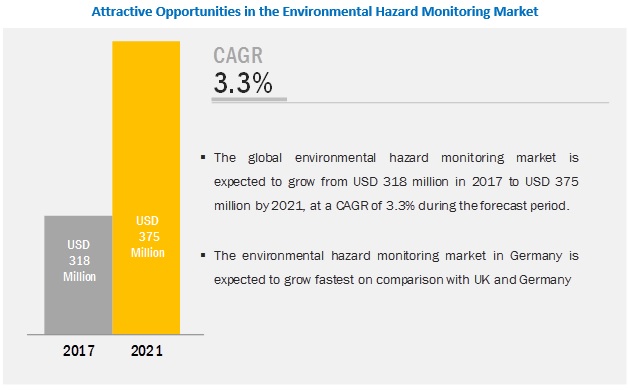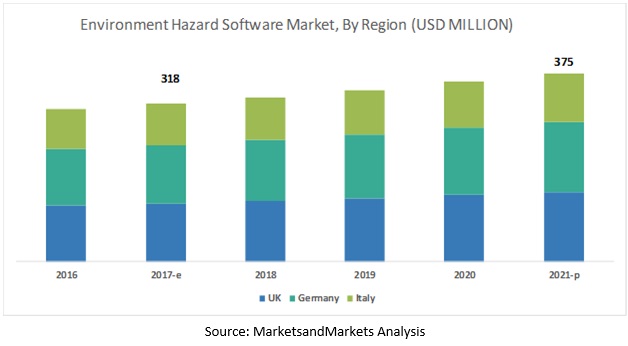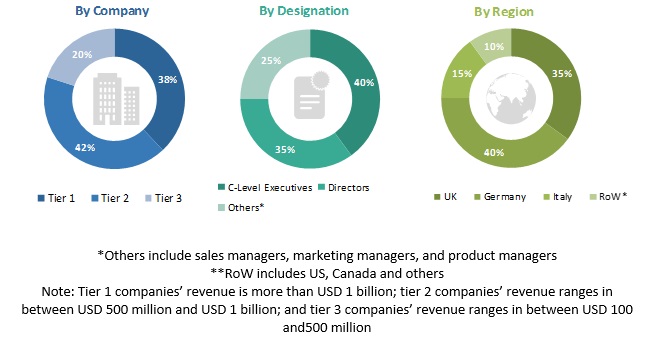Environmental Hazard Monitoring Software Market by Industry Vertical (Private, Government, Construction and Real Estate, Transportation, IT and Telecommunication and Others), and Country (UK, Germany and Italy) - Global Forecast to 2021
[100 Pages Report] The environmental hazard monitoring software Market in Italy, Germany, and UK size to grow from USD 318 million in 2017 to USD 375 million by 2021, at a Compound Annual Growth Rate (CAGR) of 3.3% during the forecast period. The growing need among government organizations to minimize losses due to natural disasters is expected to drive the growth of market over the next few years.


Germany is expected to hold the largest market size during the forecast period
Germany is expected to be the highest contributor to the Environmental Hazard Monitoring Software Market when compared with Italy and the UK. The primary factor responsible for this is the increasing instances of floods and storms across Germany over the last decade. Increasing demand for integrated systems to minimize risk and losses is expected to result in driving the growth of the market. They aim to have systems and plans for disaster and incident management. Ambiental (UK), Bigtincan (US), Badger Software (UK), CH2M (US), Everbridge (US), Palantir Technologies (US), AON (UK), KatRisk (UK), Pasi (Italy), Stonex (Italy) and Mike (Denmark).
Scope of Report
|
Report Metrics |
Details |
|
Market size available for years |
2016-2021 |
|
Base year considered |
2017 |
|
Forecast period |
2017-2021 |
|
Forecast units |
Value (USD) |
|
Segments covered |
Environmental Hazard Monitoring Software Market in Select European Countries (UK, Italy, Germany) – Forecast to 2021 |
|
Geographies covered |
UK, Germany and Italy |
|
Companies covered |
It includes 10 major vendors, namely, Ambiental (UK), Bigtincan (US), Badger Software (UK), CH2M (US), Everbridge (US), Palantir Technologies (US), AON (UK), KatRisk (UK), Pasi (Italy), Stonex (Italy) and Mike (Denmark) |
This research report categorizes the environmental hazard monitoring software market to forecast revenues and analyze trends in each of the following submarkets:
On the basis of Industry Verticals, the market has been segmented as follows:
- Private
- Government
- Other Public Sector
On the basis of Regions, the environmental hazard monitoring software market has been segmented as follows:
- UK
- Germany
- Italy
Key questions addressed by the report
- How is the adoption trend of environmental hazard monitoring across major economies?
- What are the challenges faced by environmental hazard monitoring vendors in the global market?
- The report provides insights into the countrywise Environmental Hazard Monitoring Software Market concerning different industry verticals.
Frequently Asked Questions (FAQ):
What is Environmental hazard monitoring software?
What are the top companies providing Environmental hazard monitoring software platform and services?
The top Environmental hazard monitoring software vendors are listed below:
- AMBIENTAL
- BADGERSSOFTWARE
- CH2M
- EVERBRIDGE
- PALANTIR TECHNOLOGIES INC
- AON
- KatRisk
- PASI
- STONEX
- MIKE DHI
- XP SOLUTIONS
- NORSAR
- Deltares
What are safety regulations related to Environmental hazard monitoring software?
- The Environment Agency (EA), a sponsored body of the Department for Environment, and Food and Rural Affairs of UK, has passed the Flood and Water Management Act 2010.
- The act states that the EA must develop, maintain, apply, and monitor a strategy for flood and coastal erosion risk management in England.
- In response to this, the EA in association with the Department for the Environment, Food and Rural Affairs (Defra) have developed a strategy to ensure that the underlying act for flood and risk management is incorporated in their strategies.
- The act addresses the key issues identified after the floods in 2007. It has provisions about water and management of risks such as flooding and coastal erosion.
- In addition to the above-mentioned act, there are certain safety regulations passed by the government of Scotland to develop sustainable flood disaster management.
- The Scottish Environment Protection Agency (SEPA) is Scotland’s national flood forecasting and flood warning regulatory authority, which is responsible for designing flood risk management strategies.
- The agency works closely with other organizations and provides live flooding information and guidelines.
- Furthermore, SEPA in collaboration with Scottish water and other local authorities have introduced the Flood Risk Management (Scotland) Act 2009, which tends to reduce the damages and distress caused by floods.
What are some of the programs and initiative fueling the growth of Environmental hazard monitoring software market?
The below are current market trends impacting Environmental hazard monitoring software market;
- Germany has introduced Global Initiative on Disaster Risk Management (GIDRM). It brings together a wide range of stakeholders working in public administration departments, academia, civil society, and the private sector. It provides a forum for collaborating with disaster risk management.
- GIDRM contributes to the implementation and up-scaling of effective solutions in 3 priority areas:
- Disaster response preparedness and civil protection
- Resilient critical infrastructure and economic cycles
- Early warning systems
- GIDRM contributes to the implementation and up-scaling of effective solutions in 3 priority areas:
- The implementation of More Room for rivers requires a “Flood risk reduction round table”, is a more balanced approach to manage the hazards related to water.
- The German Association for water, wastewater, and waste published studies on the assessment of the effectiveness of decentralized measures. The measures can be very effective in small catchments in case of frequent floods and have positive effects for surface water body ecologies, erosion control, and the restoration of natural water balance.
- In Germany, DWD is responsible for providing warnings on extreme weather situations, while the federal states are responsible for flood forecasting, warning, and emergency response.
- The German Strategic Cooperation Group contributes to the Climate Change Adaptation & Disaster Risk Management program.
- The global program on risk assessment and management aims at generating tried-and-tested action guidelines on climate risk assessment and management.
- The program is used by German Development Cooperation and its international partners in UNFCCC and UNISDR. It is further processed in regions severely affected by climate change.
- To take actions for effective preparedness in threatened regions and countries before any disaster, the German Federal Foreign Office utilizes the existing short-, medium-, and long-term weather forecasts. The forecasts help strengthen the weather management system and improve its preparedness for response mechanisms.
What are some of the drivers fueling the growth of Environmental hazard monitoring software market?
- Growing need to minimize losses due to climate change, land-use changes, and economic developments
- Increasing flood and storm threats have led to the rising demand for the environmental hazard monitoring software and emergency solutions in the UK
- Rising flood and earthquake threats have led to the increasing demand for the environmental hazard monitoring solutions in Italy
- Huge monitory losses due to natural disasters
- Over the last decade, the UK, Germany, and Italy have incurred monetary losses amounting to USD 18 billion, 27 billion, and 24 billion, respectively
- Increase in impact of coastal erosion made the National Coastal Erosion Risk Mapping agency highly ambitious
- The UK Environment Agency and local authorities are planning to collaborate for providing the best available information about coastal areas.
- In Germany, there is an increase in flood hazards in the areas of spatial planning and urban development
What are some of the challenges related to Environmental hazard monitoring software market?
- At the government level, there is disconnection between disaster risk-reduction strategies and emergency management. Multiple barriers such as financial, technical, human resource, and poor coordination between agencies disrupt incident and emergency management
- There was a coordination and communication problem during the cross-regional crisis in the German Civil Security System, due to a high degree of decentralization.
- Hardware infrastructure is prone to a single point of failure. For instance, in case of tsunamis or earthquakes, hardware communication lines or physical infrastructure can be completely wiped off.
- Lack of government compliances
- Due to the weak enforcement of construction restrictions and lack of compliance with floodplain principles, Italy is more vulnerable to floods, earthquakes, and other natural hazards.
To speak to our analyst for a discussion on the above findings, click Speak to Analyst

Table of Contents
1 Introduction
1.1 Research Objectives
1.2 Market Scope
1.2.1 Market Segmentation
1.3 Currency Considered
1.4 Limitations
1.5 Stakeholders
2 Research Methodology
2.1 Research Data
2.1.1 Key Data From Secondary Sources
2.1.2 Key Data From Primary Sources
2.1.3 End User Split
2.2 Research Approach
2.3 Research Assumption
3 Market Dynamics
3.1 Market Drivers
3.2 Market Restraints
3.3 Market Opportunities
3.4 Market Challenges
4 Tools Overview
4.1 Risk Assessment Tools Overview
4.1.1 Risk Assessment Tools Overview : Openquake
4.1.2 Risk Assessment Tools Overview: Capra-Hurricane
4.1.3 Risk Assessment Tools Overview : Telemac- Mascaret
4.1.4 Risk Assessment Tools Overview : Osgeo Tsunami
5 Company Profiles
5.1 Ambiental
5.2 Badgerssoftware
5.3 CH2M
5.4 Everbridge
5.5 Palantir Technologies Inc
5.6 AON
5.7 KatRisk
5.8 Pasi
5.9 Stonex
5.10 Mike DH
5.11 XP Solutions
5.12 Norsar
5.13 Deltares
6 UK Market Overview
6.1 UK Environmental Hazard Monitoring and Software Market
6.2 UK Environmental Hazard Monitoring and Software Market : By Industry Vertical
6.3 UK Market : Safety Regulations
6.4 UK Market : Impacts and Damages By Natural Disasters
6.5 UK Market : Programs and Initiatives
6.6 UK Market : Risk Mitigation Techniques and Need Gap Analysis
6.7 UK Market : Strategy and Process
6.8 UK Market : Opportunity Analysis
6.9 UK Market : Potential Buyers – Solution Mapping
6.10 UK Market : Gap Analysis From Insurers’ Perspective
6.11 UK Market : Case Study
7 Germany Market Overview
7.1 Germany Environmental Hazard Monitoring and Software Market
7.2 Germany Environmental Hazard Monitoring and Software Market : By Industry Vertical
7.3 Germany Market : Safety Regulations
7.4 Germany Market : Impacts and Damages By Natural Disasters
7.5 Germany Market : Programs and Initiatives
7.6 Germany Market : Risk Mitigation Techniques and Need Gap Analysis
7.7 Germany Market : Strategy and Process
7.8 Germany Market : Opportunity Analysis
7.9 Germany Market : Potential Buyers – Solution Mapping
7.10 Germany Market : Gap Analysis From Insurers’ Perspective
7.11 Germany Market : Case Study
8 Italy Market Overview
8.1 Italy Environmental Hazard Monitoring and Software Market
8.2 Italy Environmental Hazard Monitoring and Software Market : By Industry Vertical
8.3 Italy Market : Safety Regulations
8.4 Italy Market : Impacts and Damages By Natural Disasters
8.5 Italy Market : Programs and Initiatives
8.6 Italy Market : Risk Mitigation Techniques and Need Gap Analysis
8.7 Italy Market : Strategy and Process
8.8 Italy Market : Opportunity Analysis
8.9 Italy Market : Potential Buyers – Solution Mapping
8.10 Italy Market : Gap Analysis From Insurers’ Perspective
8.11 Italy Market : Case Study
9 Appendix
9.1 List of Partners: EFAS
9.2 List of Meteorological Data Providers: EFAS
9.3 List of Hydrological Data Providers: EFAS
9.4 Knowledge Store: Marketsandmarkets’ Subscription Portal
9.5 Authors Details
List of Tables (8 Tables)
Table 1 Key Data From Secondary Sources
Table 2 Key Data From Primary Sources
Table 3 Environmental Hazard Monitoring and Software Market Size, UK (2017–2021)
Table 4 UK Environmental Hazard Monitoring and Software Market Size, Vertical (2017–2021)
Table 5 Environmental Hazard Monitoring and Software Market Size, Germany (2017–2021)
Table 6 Germany Environmental Hazard Monitoring and Software Market Size, Vertical (2017–2021)
Table 7 Environmental Hazard Monitoring and Software Market Size, Italy (2017–2021)
Table 8 Italy Environmental Hazard Monitoring and Software Market Size, Vertical (2017–2021)
List of Figures (4 Figures)
Figure 1 Years Considered for Study
Figure 2 Environmental Hazard Monitoring and Software: Research Design
Figure 3 Data Mining and Analysis
Figure 4 Research Assumption
The study involved 4 major activities in estimating the current market size for the environmental hazard monitoring software market. Exhaustive secondary research was done to collect information on the market. The next step was to validate these findings, assumptions, and sizing with industry experts across the value chain using primary research. Both top-down and bottom-up approaches were employed to estimate the complete market size. Thereafter, the market breakup and data triangulation procedures were used to estimate the market size of the segments and subsegments of the market.
Secondary Research
In the secondary research process, various secondary sources, such as D&B Hoovers, Bloomberg BusinessWeek, and Factiva, have been referred to, to identify and collect information for this study. These secondary sources included annual reports, press releases and investor presentations of companies, whitepapers, certified publications and articles by recognized authors, gold standard and silver standard websites, regulatory bodies, trade directories, and databases.
Primary Research
The environmental hazard monitoring software market comprises several stakeholders, such as environmental hazard monitoring software vendors, system integrators, consulting service providers, managed service providers, resellers and startup companies. The demand side of the market consists of enterprises from different industry verticals, such as private, government and public sector. The supply side includes environmental hazard monitoring software providers, offering environmental hazard monitoring software and services. Various primary sources from both the supply and demand sides of the market were interviewed to obtain qualitative and quantitative information. Following is the breakup of the primary respondents:

To know about the assumptions considered for the study, download the pdf brochure
Environmental Hazard Monitoring Software Market Size Estimation
Both top-down and bottom-up approaches were used to estimate and validate the total size of the environmental hazard monitoring software market. These methods were also used extensively to estimate the size of various subsegments in the market. The research methodology used to estimate the market size includes the following:
- The key players in the industry and markets have been identified through extensive secondary research.
- The industry’s supply chain and market size, in terms of value, have been determined through primary and secondary research processes.
- All percentage shares, splits, and breakups have been determined using secondary sources and verified through primary sources.
Data Triangulation
After arriving at the overall market size using the market size estimation processes as explained above, the market was split into several segments and subsegments. To complete the overall market engineering process and arrive at the exact statistics of each market segment and subsegments, the data triangulation and market breakup procedures were employed, wherever applicable. The data was triangulated by studying various factors and trends from both demand and supply sides.
Report Objectives
- To define, describe, and forecast the environmental hazard monitoring software market by UK, Germany, Italy and vertical
- To provide detailed information about the major factors (drivers, restraints, opportunities, and industry-specific challenges) influencing the growth of the market
- To analyze the market with respect to individual growth trends, prospects, and contributions to the market
- To forecast the market size into 3 countries namely, UK, Germany and Italy
- To analyze the competitive developments, such as agreements, partnerships, acquisitions, and product/solution launches in the market
Available Customizations
With the given market data, MarketsandMarkets offers customizations as per the company’s specific needs. The following customization options are available for the report:
Product Analysis
- Product matrix gives a detailed comparison of the product portfolio of each company
Company Information
- Detailed analysis and profiling of additional market players















Growth opportunities and latent adjacency in Environmental Hazard Monitoring Software Market